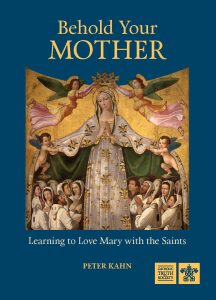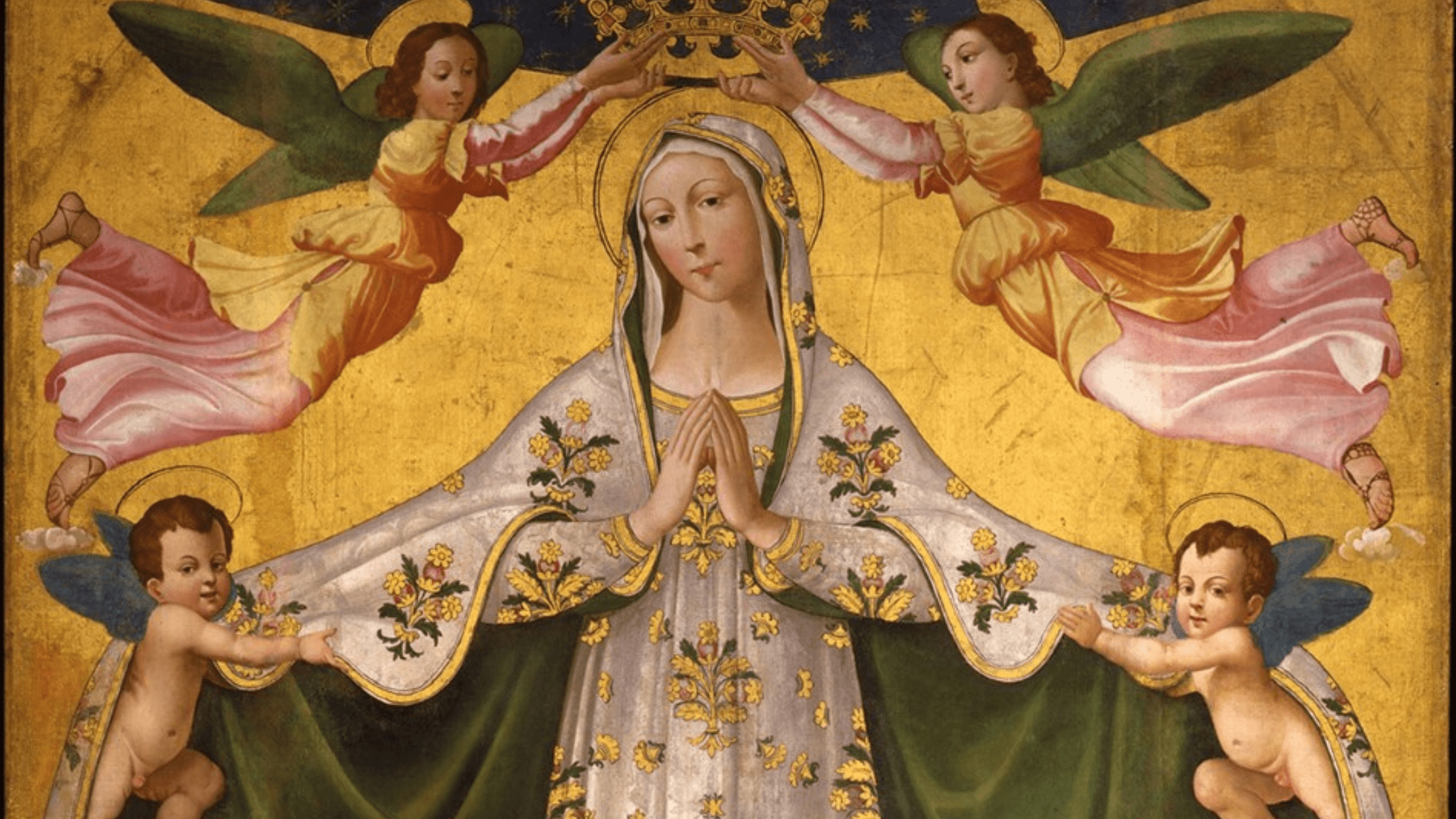This blog is an exclusive extract from our book Behold Your Mother. Available to order now.
After she had been a Carmelite nun for several years, St Thérèse of Lisieux was given the task of writing her autobiography. At the start of the book, St Thérèse recalls that she set about her duty by kneeling before a statue of Our Lady. The statue had come to the convent from her own family. She had received many proofs of her heavenly mother’s loving care before this statue. Indeed, St Thérèse and her earthly mother had each experienced an occasion when the statue seemed to come to life. At the start of her writing, she begged her dear Mother Mary to “guide my hand, and thus ensure that only what was pleasing to her should find place here”. St Thérèse had, by then, become accustomed to always looking towards Our Lady in every want that she experienced. For instance, according to one of her sisters, she would at times, prior to receiving Holy Communion, imagine that she was three years old, with ruffled hair and a dirtied smock. She had explained that all that was required was a little attention from Our Lady, who would make her presentable, arrange her hair and present her with a ribbon or a flower – then she would be ready to sit down at the banquet of angels.
Any experience of a lack of something was an occasion for St Thérèse to give expression to her “Little Way”, by which she accepted her own insignificance and made sacrifices as an integral aspect of daily life. Thérèse was keenly aware that Our Lady was well placed to provide for her at any given time. Each one of us needs help from God, whether to convert from a life of sin, in the face of personal difficulties, in our attempts to help others or when oppressed by enemies of whatever kind. When God provides our necessities through Mary’s hands, then we become more affectionate towards our spiritual mother, and our trust in God grows. To ask for help from Mary is, in its own way, to call her blessed, because we recognise in making the request that she has blessings to share with us.
Deliver us from dangers
As the mother of Christ, the King, Our Lady is able to meet our needs. The Davidic kings of Israel accepted requests that came to them through their mothers. One of the functions of the Queen Mother in ancient Israel was to present to the king requests from the people. In 1 Kings 2, we see Adonijah come to Bathsheba, King Solomon’s mother. He was confident that the king would grant his request if Bathsheba were to forward it on. Adonijah said to her, “He will not refuse you.” When Elizabeth addressed Mary as “the mother of my Lord” (Lk 1:43), she connected directly with these traditions of the Israelite royal court, given that the phrase “my Lord” was used to address royalty.
It is no wonder that we see Jesus honouring a request from his mother in John’s Gospel. In response to his mother pointing out that the wedding party had run out of wine, Jesus answered, “Woman, what does this have to do with me? My hour has not yet come” (Jn 2:4). In saying this, Jesus implied that the hour would come when he would honour all his mother’s requests. Even so, Jesus still honoured this more immediate request.
It did not take long for this biblical tradition to manifest itself in the life of the Church. The earliest known prayer for the intercession of Our Lady is the Sub Tuum Praesidium: “We fly to thy patronage, O holy Mother of God; despise not our petitions in our necessities, but deliver us from all dangers, O glorious and blessed Virgin.” A copy of this prayer was found in Egypt on a fragment of parchment. It has been dated to the third century on the basis of analysis of historic writing. The prayer’s use of the first-person plural suggests a communal setting for its recitation. Only one side of the papyrus, though, contains writing, which suggests that the copy was used as part of a popular devotion rather than within a liturgy. The first part of the prayer acknowledges the graces that God granted to Mary. Calling her blessed in this way makes it possible to seek God’s help through her, so that we, too, can grow in charity and share in the transformative grace that she received. In this way, we too receive blessings from God.
One hand shot, and another guided the bullet
Who is there who does not experience an intense sense of helplessness at times and the need to call out to God for assistance? We can expect Our Lady to hear our prayers, partly because of the depths of her own suffering. A sword pierced her heart at the foot of the cross. Mary is close to us in our trials.
In his spiritual diaries entry for a meditation on 3rd November 1962, Pope St John Paul II indicated that he felt himself very much in Mary’s hands and close to God in relation to two specific issues. He did not name the two issues in his diary, but he did wonder whether he was using such feelings for his own ends. He realised, though, that God was using these two issues to assist in his redemption, so that he would convert and give himself over completely to God by turning to Our Lady.
It was well that John Paul had learned to turn to Our Lady in times of difficulty. An assailant shot him multiple times in the abdomen when he entered St Peter’s Square for an audience in 1981. His private secretary, Stanislaw Dziwisz, recalled that in the ambulance afterwards, eyes closed and in great pain, John Paul kept on praying, “Mary, my mother!” The assassination attempt occurred on 13th May, the anniversary of the first of the apparitions in Fátima.
It is well known that John Paul attributed his survival to the intercession of his heavenly mother. He said, “One hand shot, and another guided the bullet.” He visited Fátima exactly a year later to thank Our Lady for her intervention in his life.
Red from the blows
St Maximilian Kolbe similarly took trials that he experienced as opportunities to come close to the Immaculata. The German authorities closed Maximilian’s monastery in 1941, a little while after the invasion of Poland. The Gestapo, the German secret state police, subsequently arrested him and confined him to a prison, before transferring him to Auschwitz. The guards in Auschwitz regularly beat him, given that he continued with his priestly ministry. On one occasion, a sergeant tore Maximilian’s rosary beads away from him. The sergeant shoved the crucifix on the rosary towards him and asked if he believed in it. When Maximilian responded “Yes”, the sergeant struck him in the face. This routine was repeated several times in a row. When the sergeant moved on, Maximilian’s compatriots tried to comfort him. Maximilian, however, said that the whole thing was of no consequence and that they should not be concerned for him. He said that he had borne with the insults simply for love of Mary. He then just continued with his prayers. The witnesses would not have known that anything at all had happened, except that his face was still red from the blows.
Is it any surprise that in the face of oppression from others Maximilian would turn to the woman who – when we remember how in 1 Samuel the presence of the Ark repeatedly brought victory to the Israelites over their Philistine enemies – was the new Ark of the Covenant? It is reported that the final prayer on the lips of St Maximilian as he was killed in Auschwitz was the Hail Mary.
The second part of this prayer, of course, runs as follows: “Holy Mary, mother of God, pray for us sinners now and at the hour of our death.” This part of the Hail Mary first appeared in print at the end of the fifteenth century. The first part of the Hail Mary opens up a sense of wonder and certainty at God’s action in Mary’s life, preparing us for the second part of the prayer, in which we seek God’s assistance in the needs that we experience in each present moment and in anticipation of our death.
A lifetime of closeness to Mary similarly enabled St Bernadette to seek Our Lady’s assistance on her deathbed. One night as she lay seriously ill, Bernadette asked a specific sister to help her call on Our Lady at the hour of her death. The next day, Bernadette held out her arms to the sister and fixed her eyes on her, but the sister did not understand what she meant by these signs. Bernadette’s last words were to say to this sister, “For you to help me.” The sister then recalled what she had agreed with Bernadette and led those at the bedside in a prayer of thanksgiving to Our Lady. St Bernadette died almost immediately after this prayer.
Jesus always triumphs
There are, however, countless examples of the saints turning to Our Lady in more mundane settings as well. St Thérèse was appointed the assistant novice mistress for her monastery in 1893, even before she had formally left the novitiate herself. She met her four novices every day for half an hour from 2.30 p.m. until 3 p.m. If she ever found herself making a misstep in her advice to them – perhaps toning down some truth that her novices needed to hear – she indicated how “at once I have recourse to prayer, I turn to Our Blessed Lady, and Jesus always triumphs.”8 To the novices themselves, it seemed as if St Thérèse was able to read their innermost thoughts. In response to a query about this from her novices, she replied:
Here is my secret. I never make remarks to you before I have invoked the Blessed Virgin. I ask her to inspire me with what will do you the most good. Often I myself am astonished at the things I teach you. In telling you these things, I feel simply that I am not mistaken, and that Jesus speaks through me.
Experience taught her that prayer was far more effective in touching someone else’s heart than mere words. What would it mean if each one of us was able to find a way to turn to Mary in the face of the challenges that we encounter each day?
Continue Reading Behold Your Mother
 Behold Your Mother tells stories about ways the saints encountered Our Lady, not necessarily through the miraculous, but rather as their spiritual mother in everyday life, showing that any growth in our awareness of Mary’s presence and care for us deepens our relationship to Christ.
Behold Your Mother tells stories about ways the saints encountered Our Lady, not necessarily through the miraculous, but rather as their spiritual mother in everyday life, showing that any growth in our awareness of Mary’s presence and care for us deepens our relationship to Christ.
Learn more about loving Mary with the saints by ordering your copy of Behold Your Mother today.
